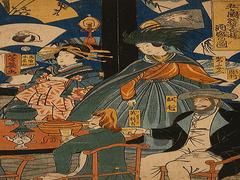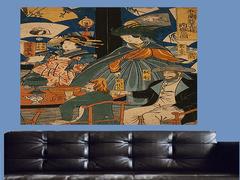Ukiyo-e
Introduction
Ukiyo-e, meaning "pictures of the floating world," stands as one of the most celebrated and influential art forms in Japanese history. These exquisite woodblock prints capture the essence of life during the Edo period (1603-1868) and offer a glimpse into the vibrant culture and transient pleasures of the time. In this article, we embark on a journey to explore the captivating world of ukiyo-e, unraveling its origins, themes, techniques, and enduring legacy.
Origins and Development
Ukiyo-e emerged in the 17th century, a time when Japan experienced an era of peace, prosperity, and urbanization. The rise of the merchant class led to a flourishing popular culture centered around entertainment districts, theaters, and pleasure quarters. Artists began depicting this "floating world" through woodblock prints, which were affordable and accessible to a wide audience.
The Early Masters
Hishikawa Moronobu, a pioneer of ukiyo-e, laid the foundation for the art form with his bold, black ink sketches of Kabuki actors and courtesans. These prints were often produced in monochrome, using only black ink. Moronobu's work paved the way for future ukiyo-e artists to experiment with color and composition.
The Golden Age
The 18th and 19th centuries marked the golden age of ukiyo-e, with the emergence of renowned artists who achieved mastery in the medium. Artists such as Kitagawa Utamaro, Katsushika Hokusai, and Utagawa Hiroshige elevated ukiyo-e to unprecedented heights, creating iconic prints that captivated audiences then and continue to inspire today.
Themes and Subjects
Ukiyo-e prints depicted a wide array of subjects, encompassing landscapes, portraits, historical events, myths, legends, and scenes from everyday life. The genre of bijinga (pictures of beautiful women) became particularly popular, showcasing graceful courtesans, geisha, and ordinary women engaged in various activities. Kabuki actors, sumo wrestlers, landscapes, and famous landmarks also featured prominently.
Woodblock Printing Process
The creation of ukiyo-e prints involved a collaborative effort among artists, woodblock carvers, and printers. The artist designed the composition, which was then transferred to separate wooden blocks. Skilled carvers meticulously carved the image into the blocks, and printers applied ink to each block before pressing it onto paper. The process required precision, patience, and expertise to achieve the desired effect.
Color and Techniques
Color played a vital role in ukiyo-e prints, enhancing the visual impact and narrative of the artworks. Initially, prints were hand-painted, but later, artists developed techniques using multiple woodblocks to introduce a wide range of colors. Notable techniques included "nishiki-e" (brocade prints) and "bokashi" (gradation of color). The use of vibrant pigments, delicate shading, and meticulous attention to detail distinguished ukiyo-e prints as masterpieces of craftsmanship.
Impact and Influence
Ukiyo-e prints had a profound impact on Japanese society, shaping perceptions, disseminating information, and reflecting the popular culture of the time. They also influenced Western art movements, particularly during the late 19th century when Japan opened up to the world. Artists like Vincent van Gogh, Claude Monet, and James McNeill Whistler drew inspiration from ukiyo-e, adopting its flattened perspective, asymmetrical compositions, and exploration of light and color.
Preservation and Legacy
The preservation of ukiyo-e prints is crucial to safeguarding their historical and artistic value. Museums and galleries worldwide house extensive collections, allowing audiences to appreciate the beauty and cultural significance of these prints. Efforts are also underway to train new generations of woodblock printers and ensure the continuity of traditional techniques.
Conclusion
Ukiyo-e stands as a testament to the rich artistic heritage of Japan. Through the delicate strokes, vibrant colors, and intricate details of these woodblock prints, we are transported to a world of beauty, entertainment, and fleeting moments. As we explore the history, themes, techniques, and lasting impact of ukiyo-e, we gain a deeper appreciation for this remarkable art form that continues to inspire and captivate audiences across the globe.
- Unveiling the Artistic Process: Steps of Woodblock Printing
- Japanese Woodblock History - Ukiyo-e: The Floating World Unveiled - A Journey into the Artistic Splendor of Japanese Woodblock Prints
- Nature and Seasons in Japanese Woodblock Prints
- The History of Japanese Woodblock Printing
- The Artistic Journey: Exploring the Rich History of Japanese Woodblock Prints
- The Birth of a Revolutionary Technique: Woodblock Printing and the Tang Dynasty
- The Innovative Legacy: How Woodblock Printing Led to Remarkable Inventions
- The Significance of Japanese Woodblock Printing: A Timeless Artistic Legacy
- Unlocking the Beauty: How to Identify Japanese Woodblock Prints
- Unveiling the Ancient Art: Exploring the Oldest Japanese Woodblock Print




